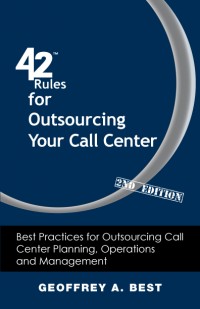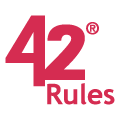42 Rules for Outsourcing Your Call Center (2nd Edition)

What’s it about?
“42 Rules for Outsourcing Your Call Center (2nd Edition)” is a compilation of real-life problems, lessons learned, pitfalls found, and practical approaches for planning, implementing, and outsourcing call center operations. It provides a path for companies outsourcing their first call center with a logical sequence of steps for moving an existing operation to an outsourced organization. This management book is a foundation for anyone considering outsourcing their call center. It starts by answering the question “Why Outsource,” and then guides the reader with rules from defining the project to selecting a vendor to the first go-live call.
Businesses continue to be challenged to find ways to minimize costs and maximize profits while retaining their customers with excellent service. They need to focus on customer retention and realize that running their own contact centers is not their core competence. These businesses need outsourcers that can deliver high customer satisfaction and execute cross-sell/up-sell revenue strategies.
“42 Rules for Outsourcing Your Call Center (2nd Edition)” takes the reader through the entire process from gathering requirements and setting goals, to identifying an outsourcing strategy and understanding and operational capabilities of a outsource partner. The reader will learn:
- When outsourcing makes sense
- How to define an outsourcing approach
- What to look for in an outsourcing partner
- When to determine if agents can work at home
- How to craft an effective RFP
“42 Rules for Outsourcing Your Call Center (2nd Edition)” is a must-have for all call center managers hoping to improve customer satisfaction, increase customer retention and turn their call center into a revenue generating machine.
Author Geoffrey A. Best started in the computer industry in the 1970’s and has worked with call centers for over 20 years. His experience has provided him with insight into the systems and methods that companies use to operate their call centers and service their customers.
What they’re saying.
“Geoffrey has written the comprehensive resource for understanding the complexities of modern day contact center management. From customer experience design to the fundamentals of IT infrastructure, this book provides not only the right topics, but also the deeper insights required to maximize the effectiveness of a contact center operation. I highly recommend this book whether you’re an experienced contact center leader or someone that needs to quickly learn the intricacies of outsourcing.” Scott McIntyre, Chief Investigator, Infinite Green Consulting
“Geoffrey has captured the fundamentals for how to outsource a call center in a logical step-by-step process that exposes the reader to real-life scenarios. ’42 Rules for Outsourcing Your Call Center (2nd Edition)’ provides an encompassing view into what is necessary to plan and deploy a call center using a BPO and I recommend it for anyone that is contemplating this challenging task.” Nick Jiwa, Director of CustomerServ, LTD
What’s in the book.
Here’s a sample of the actionable content in this book:
Rule 2 Ask “Why Outsource?”
Rule 4 Know Your Customer Expectations
Rule 25 Establish Security Guidelines
You can register for a free book excerpt on the right side of the page. Just complete the form and we’ll email it right to you.
Watch The Webcast
Registration with the BrightTALK network is free and gives you access to all 42Rules webcasts plus thousands more across their network.


